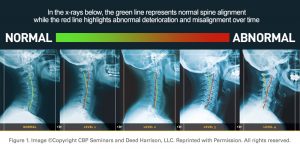Research shows importance of cervical curve on overall health.
In our technology culture, the repetitive use of cell phones and computers causes increased stress and strain on the neck, resulting in forward head posture and flattening of the curve in the neck. Every inch forward the skull leans over the body causes an additional 10 lbs of pressure on the spine. A normal curvature in the neck is between 39-45 degrees.

A team of researchers evaluated the effects of chronic compression, associated with cervical kyphosis (reversal of cervical curvature) on the cervical spine and spinal cord.
The study “Spinal kyphosis causes demyelination and neuronal loss in the spinal cord,” was done at the Department of Orthopaedic Surgery, School of Medicine, Keio University, in Tokyo, Japan, and published in Spine Journal.
In the study, surgical spine procedures were performed at the C4–C5 level in 52 small game fowls to induce change in normal biomechanics of the cervical spine.
In all operated animals, there was a significant correlation between progressive kyphosis (loss of cervical curve) with spinal cord compression. Demyelination (damage to the protective covering of surrounding nerve fibers) as well as neuronal loss and atrophy (breakdown of tissue) were observed. Demyelination progressed as the kyphotic deformity became more severe. Mechanical compression and vascular changes in the spinal cord were observed, resulting in decreased blood flow through the carotid arteries.
The research study highlights the negative long term effects of Subluxation (reduced spinal motion) leading to;
- degeneration of the spine
- loss of normal spinal curvature
- spinal cord compression
- reduced vascular flow
Chiropractic care helps improve motion in the spine and reduce spinal cord tension. Get your spine checked by a Chiropractor and experience greater health and vitality!
Reference
Shimizu, Kentaro, et al. “Spinal Kyphosis Causes Demyelination and Neuronal Loss in the Spinal Cord.” Spine, vol. 30, no. 21, Nov. 2005, pp. 2388–2392.